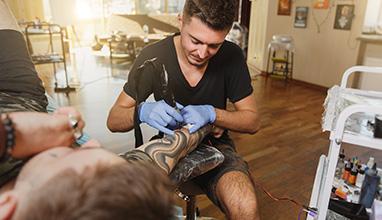The job security an individual can enjoy as a tattoo artist will vary greatly based upon the location in which he or she lives and the quality of their work. There is very little statistical data available for this career choice, although below is a roundup of the information available regarding the job outlook for a tattoo artist.
Outlook by Location
Tattoo artists who work in large metropolitan areas often believe that they will enjoy a larger client base than those who work in more rural locations, but this is not always the case. Tattoos are becoming more socially acceptable with each passing year, and as a result, more and more people are seeking the services of tattoo artists. These days, there are multiple tattoo parlors in big cities—even thousands in locations like New York City and Los Angeles. This means that the job outlook for a tattoo artist depends upon the location, the number of individuals in that location who are interested in being tattooed and the amount of competition that is present within the geographical area.
Outlook by Quality of Work
Like any artist, a tattoo artist can only be successful and enjoy a solid job outlook if people enjoy the quality of his or her work. If these artists choose to open their own parlors, they will not only be judged by the quality of their work, but also by the quality of the work performed by their employees. Should a tattoo artist choose to apply for a position within an existing tattoo parlor, the quality of their work is often the deciding factor. No amount of training, experience or understanding of the industry can make up for artistry that is not enjoyed or appreciated by the clients. Conversely, an artist whose work is known and appreciated by many can be successful despite the amount of surrounding competition.
Reasons for Growth or Decline
The growth and decline of the tattoo industry is often sporadic. As an example, the tattoo industry was thriving in the mid- to late-1950s, and people often traveled from miles around to get tattoos from famous artists in New York City. However, following a hepatitis outbreak in 1961, the entire industry came to a grinding halt. With new measures in place to prevent such infections, this is highly unlikely these days; however, there is still a social stigma that surrounds tattoos and body art in general, so the industry often fluctuates as tattoos go in and out of style. The industry may also decline in communities that are home to aging populations and thrive in locations where younger generations tend to flock.
Job Prospects
Individuals who want to work as tattoo artists will often experience the greatest levels of success if they are licensed to operate in their states, live in locations that are home to younger generations and have obtained the education and experience necessary to build a reputation. However, the greatest factor that must be considered is the quality of work that the artist can provide. As a whole, it is projected that the tattoo and body art industry will see slow but steady growth over the next decade.
Tattoo artists certainly have an exciting job because they meet new people every day and create permanent artwork that their customers will carry with them for a lifetime. Enjoying the greatest level of success is possible with some work, patience and practice.






